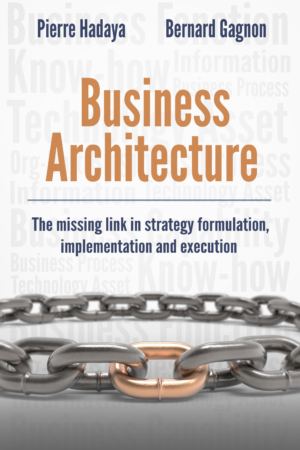Business Architecture Book

Available at
Praise for the book
“Pierre Hadaya and Bernard Gagnon offer readers a practical and inspiring handbook for bridging the gap between formulating, implementing and executing an organization’s strategy. Let yourselves be seduced by this refreshing manifesto for business architecture. “
Prof. Yves Pigneur, HEC Lausanne
Author with Alex Osterwalder of "Business Model Generation"
“Highly recommended! Superb book, well-researched and consistent. Bernard and Pierre have gone right back to the first principles of WHY we need to take a strategic approach to architecture and go beyond the technical to the business value. Their approach to capability modeling, for example, goes way beyond the traditional and gets into comprehensive qualification of what makes up a complete and robust capability.“
Vernon Smith
Founder and CEO at FIOS Insight, LLC
“This book gave me a global vision of the organizational transformation process. It enables me to better assess the current state of an organization and identify opportunities for improvement that are invaluable to the formulation, implementation, and execution of a strategy. This book provides me with the essential tools I need to make even greater contributions to the global enterprise architecture team I am part of. A must read, this book should be on the bookshelf of all executives, managers, and professionals involved in organizational transformation.”
Alexis Henríquez Bugueño, Finning International Inc.
Blog: alexishenriquez.com
Book Description
The goal of this book is to describe what business architecture is; how it can help meet the challenge of formulating, implementing, and executing an organization’s strategy; and how to build and exploit a superior strategy management system that leverages business architecture. The book also includes an extensive presentation of the business architecture framework and of the transformation plan elaboration methodology we have developed over the years.
Book contents
The chapters of the book answer the following important questions about business architecture:
1 – Introduction
What are the key issues that persist in strategy formulation, implementation, and execution? What is business architecture and how can it help alleviate or eliminate these issues?
2 – Contributing To Strategy Formulation
What is a strategy and what is a strategic plan? What are their key components? What are the strategy formulation activities and how can business architects contribute to them? How should a strategy be codified?
3 – Architecting the Target Business Architecture
What are the core concepts used in designing a business architecture? How do these concepts relate to each other and to concepts used by strategists and IT enterprise architects? What are the main target business architecture design guidelines? What types of models should be used to document a business architecture?
4 – Elaborating the Transformation Plan
What are the characteristics and components of a well-designed transformation plan? What methodology should be used to identify, select and prioritize transformation projects?
5 – Engaging and Governing
How can business architects help motivate and get buy-in from all involved stakeholders, and how can they help remove barriers to the formulation, implementation, and execution of their organization’s strategy? What are the key strategy formulation, implementation, and execution governance activities and how can business architects contribute to them?
6 – Putting it All Together
How can an organization leverage business architecture and other best practices to create a strategy management system that will enable it to surmount the challenges of formulating, implementing and executing its strategy?
7 – The Leadership Agenda
What are the key business-architecture-related principles? What activities should leaders initiate, contribute to and oversee to start integrating business architecture into the strategy management system of their organization?
Description
History has shown that having a competitive advantage is critical to the success and long-term viability of all organizations. However, creating and sustaining such an advantage is a challenge. Organizations must formulate a winning strategy, surpass competitors at implementing and executing it, and excel at adapting in response to internal and external events. Although organizations have applied numerous best practices to help them succeed in their strategic endeavors, they still face serious difficulties, which they can only surmount by adopting business architecture. The goal of this book is to describe what business architecture is; how it can help meet the challenge of formulating, implementing and executing an organization’s strategy; and how to build and exploit a superior strategy management system that leverages business architecture. The book also includes an extensive presentation of the business architecture framework and of the transformation plan elaboration methodology we have developed over the years.
Book contents
The chapters of the book answer the following important questions about business architecture:
1 – Introduction
What are the key issues that persist in strategy formulation, implementation, and execution? What is business architecture and how can it help alleviate or eliminate these issues?
2 – Contributing To Strategy Formulation
What is a strategy and what is a strategic plan? What are their key components? What are the strategy formulation activities and how can business architects contribute to them? How should a strategy be codified?
3 – Architecting the Target Business Architecture
What are the core concepts used in designing a business architecture? How do these concepts relate to each other and to concepts used by strategists and IT enterprise architects? What are the main target business architecture design guidelines? What types of models should be used to document a business architecture?
4 – Elaborating the Transformation Plan
What are the characteristics and components of a well-designed transformation plan? What methodology should be used to identify, select and prioritize transformation projects?
5 – Engaging and Governing
How can business architects help motivate and get buy-in from all involved stakeholders, and how can they help remove barriers to the formulation, implementation, and execution of their organization’s strategy? What are the key strategy formulation, implementation, and execution governance activities and how can business architects contribute to them?
6 – Putting it All Together
How can an organization leverage business architecture and other best practices to create a strategy management system that will enable it to surmount the challenges of formulating, implementing and executing its strategy?
7 – The Leadership Agenda
What are the key business-architecture-related principles? What activities should leaders initiate, contribute to and oversee to start integrating business architecture into the strategy management system of their organization?
